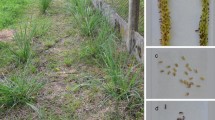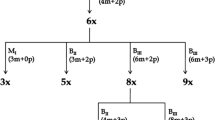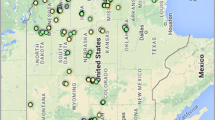Abstract
The co-occurrence of apomixis (asexual reproduction) and polyploidy in plants has been the subject of debate in regard to the origin and evolution of asexuality. In recent years, polyploidy has been postulated as a maintenance and stabilization factor rather than as a source of apomixis origin. It is assumed polyploidy facilitates the compensation for mutation accumulation, and hence, the rare occurrence of diploid apomixis indirectly supports this finding. Nevertheless, diploid apomicts exist and are successful, especially in the genus Boechera. While comparing phenotypic traits, fitness-related traits and apomixis penetrance between both diploid and triploid apomicts in the genus Boechera, it was expected to find trait variance that can be attributed to ploidy. Surprisingly, little trait variation could be assigned to ploidy, but rather trait variations were mainly genotype-specific. Additionally, it is shown that paternal contribution is very important for trait success, even though all offspring are genetically identical to the mother plant. This harbors implications for the introduction of apomixis into crop plants, considering the effects of paternal contribution during asexual reproduction. Nevertheless, polyploidy is an efficient way to buffer deleterious mutations, but the flexibility of diploid apomicts of the genus Boechera for rare sexual events contributes to their success in nature.

Similar content being viewed by others
References
Adams S, Vinkenoog R, Spielman M, Dickinson HG, Scott RJ (2000) Parent-of-origin effects on seed development in Arabidopsis thaliana require DNA methylation. Development 127:2493–2502
Adamski NM, Anastasiou E, Eriksson S, O’Neill CM, Lenhard M (2009) Local maternal control of seed size by KLUH/CYP78A5-dependent growth signalling. Proc Natl Acad Sci USA 106:20115–20120
Aliyu OM, Schranz ME, Sharbel TF (2010) Quantitative variation for apomixis components in the genus Boechera. Am J Bot 97:1719–1731
Alonso-Blanco C, Blankestijn-de Vries H, Hanhart CJ, Koornneef M (1999) Natural allelic variation at seed size loci in relation to other life history traits of Arabidopsis thaliana. Proc Natl Acad Sci USA 96:4710–4717
Al-Shehbaz IA, Windham MD (2006) New and noteworthy species of Boechera (Brassicaceae) I: sexual diploids. Harv Paper Bot 11:61–88
Al-Shehbaz IA, Windham MD (2007a) New and noteworthy species of Boechera (Brassicaceae) II: apomictic hybrids. Harv Paper Bot 11:257–274
Al-Shehbaz IA, Windham MD (2007b) New and noteworthy species of Boechera (Brassicaceae) III: additional sexual diploids and apomictic hybrids. Harv Paper Bot 12:235–257
Asham TL, Penet L (2007) Direct and indirect effects of a sex-biased antagonist on male and female fertility: consequences for reproductive trait evolution in a gender dimorphic plant. Am Nat 169:595–608
Asker S, Jerling L (1992) Apomixis in plants. CRC Press, Boca Raton
Bierzychudek P (1985) Patterns in plant parthenogenesis. Experientia 41:1255–1264
Böcher TW (1951) Cytological and embryological studies in the amphi-apomictic Arabis holboellii complex. K Dan Vidensk Selsk 6:1–59
Bretagnolle F, Lumaret R (1995) Bilateral polyploidization in Dactylis glomerata L. subsp. lusitanica: occurrence, morphological and genetic characteristics of first polyploids. Euphytica 84:197–207
Carman JG (1997) Asynchronous expression of duplicate genes in angiosperms may cause apomixis, bispory, tetraspory, and polyembryony. Biol J Linn Soc 61:51–94
Casco H, Dias LS (2008) Estimating seed mass and volume from linear dimensions of seeds. Seed Sci Technol 36:230–236
Chambers JM, Cleveland WS, Kleiner B, Tukey PA (1983) Graphical methods for data analysis. Duxbury Press, Boston
Comai L (2005) The advantages and disadvantages of being polyploid. Nat Rev Genet 6:836–846
Cortex Nova (2005) DigiShape. Software for automatic morphometry. Cortex Nova, Bydgoszcz. http://www.cortex.nova.pro.wp.pl
Cosendai AC, Hörandl E (2010) Cytotype stability, facultative apomixis and geographical parthenogenesis in Ranunculus kuepferi (Ranunculaceae). Ann Bot 105:457–470
Crawley MJ (2005) Statistics: an introduction using R. Wiley, Chichester, pp 181–185
D’Souza TG, Storhas M, Schulenburg H, Beukeboom LW, Michiels NK (2004) Occasional sex in an ‘asexual’ polyploid hermaphrodite. Proc R Soc London Ser B 271:1001–1007
de Jong TJ, Scott RJ (2007) Parental conflict does not necessarily lead to the evolution of imprinting. Trends Plant Sci 12:439–443
de Jong TJ, Hermans CM, van der Veen-van Wijk KAM (2011) Paternal effects on seed mass in Arabidopsis thaliana. Plant Biol 13:71–77
de Kovel CGF, de Jong G (1999) Responses of sexual and apomictic genotypes of Taraxacum officinale to variation in light. Plant Biol 1:541–546
Dilkes BP, Comai L (2004) A differential dosage hypothesis for parental effects in seed development. Plant Cell 16:3174–3180
Dobeš C, Mitchell-Olds T, Koch MA (2004a) Intraspecific diversification in North American Boechera stricta (= Arabis drummondii), Boechera × divaricarpa, and Boechera holboellii (Brassicaceae) inferred from nuclear and chloroplast molecular markers-an integrative approach. Am J Bot 91:2087–2101
Dobeš C, Mitchell-Olds T, Koch MA (2004b) Extensive chloroplast haplotype variation indicates Pleistocene hybridization and radiation of North American Arabis drummondii, A. xdivericarpa, and A. holboellii (Brassicaceae). Mol Ecol 13:349–370
Dobritsa AA, Lei Z, Nishikawa SI, Urbanczyk-Wochniak E, Huhman DV, Preuss D, Sumner LW (2010) LAP5 and LAP6 encode anther-specific proteins with similarity to chalcone synthase essential for pollen exine development in Arabidopsis. Plant Physiol 153:937–955
Dorcey E, Urbez C, Blázquez MA, Carbonell J, Perez-Amador MA (2009) Fertilization-dependent auxin response in ovules triggers fruit development through the modulation of gibberellin metabolism in Arabidopsis. Plant J 58:318–332
Dorn RD (1984) Vascular plants of montana. Mountain West Publishing, Cheyenne
Dumas C, Rogowsky P (2008) Fertilization and early seed formation. C R Biol 331:715–725
Garcia D, Fitz Gerald JN, Berger F (2005) Maternal control of integument cell elongation and zygotic control of endosperm growth are coordinated to determine seed size in Arabidopsis. Plant Cell 17:52–60
Greilhuber J, Doležel J (2009) 2C or not 2C: a closer look at the nuclei and their DNA content. Chromosoma 188:391–400
Grimanelli D, Leblanc O, Perotti E, Grossniklaus U (2001) Developmental genetics of gametophytic apomixis. Trends Genet 17:597–604
Gustafsson Å (1946–1947) Apomixis in higher plants. I-III Lunds Univ Årsskr 2:42
Hahn SK, Bai KV, Asiedu R (1990) Tetraploids, triploids, and 2n pollen from diploid interspecific crosses with cassava. Theor Appl Genet 79:433–439
Haig D, Westoby M (1991) Genomic imprinting in endosperm: its effects on seed development in crosses between different ploidies of the same species, and its implications for the evolution of apomixis. Philos Trans R Soc B 333:1–13
Hochholdinger F, Hoecker N (2007) Towards the molecular basis of heterosis. Trends Plant Sci 12:427–432
House C, Roth C, Hunt J, Kover PX (2010) Paternal effects in Arabidopsis indicate that offspring can influence their own size. Proc R Soc London Ser B 277:2885–2893
Izmaiłow R (1996) Reproductive strategy in the Ranunculus auricomus complex (Ranunculaceae). Acta Soc Bot Pol 65:167–170
Jaranowski J, Kalasa M (1971) Comparative analysis of fertility in several Trifolium, Melilotus, Medicago and Trigonella species and forms on a di- and tetraploid level. Genet Pol 12:1–16
Jofuku KD, Omidyar PK, Gee Z, Okamuro JK (2005) Control of seed mass and seed yield by the floral homeotic gene APETALA2. Proc Natl Acad Sci USA 102:3117–3122
Kantama L, Sharbel TF, Schranz EM, Mitchell-Olds T, De Vries S, De Jong H (2007) Diploid apomicts of the Boechera holboellii complex display large scale chromosome substitutions and aberrant chromosomes. Proc Natl Acad Sci USA 104:14026–14031
Kao RH (2007) Asexuality and the coexistence of cytotypes. New Phytol 175:764–772
Kearney M (2005) Hybridization, glaciation and geographical parthenogenesis. Trends Ecol Evol 20:495–502
Kiefer C, Dobeš C, Sharbel TF, Koch MA (2009) Phylogeographic structure of the chloroplast DNA gene pool in North American Boechera—a genus and continental-wide perspective. Mol Phylogenet Evol 52:303–311
Koch M, Bishop J, Mitchell-Olds T (1999) Molecular systematics and evolution of Arabidopsis and Arabis. Plant Biol 1:529–537
Koch M, Dobeš C, Mitchell-Olds T (2003) Multiple hybrid formation in natural populations: concerted evolution of the internal transcribed spacer of nuclear ribosomal DNA (ITS) in North American Arabis divaricarpa (Brassicaceae). Mol Biol Evol 20:338–350
Kuspira J, Bhambhani RN, Shimada T (1985) Genetic and cytogenetic analyses of the A genome of Tritium gonococcus. I. Cytology, breeding behaviour, fertility, and morphology of induced autotetraploids. Can J Genet Cytol 27:51–63
Levin DA (1983) Polyploidy and novelty in flowering plants. Am Nat 122:1–25
Levin, DA (2002) The role of chromosomal change in plant evolution. Oxford University Press, New York
Li Y, Zheng L, Corke F, Smith C, Bevan MM (2008) Control of final seed and organ size by the DA1 gene family in Arabidopsis thaliana. Genes Dev 22:1331–1336
Lin BY (1984) Ploidy barrier to endosperm development in maize. Genetics 107:103–115
Lo Eugenia YY, Stefanovic S, Dickinson TA (2009) Population genetic structure of diploid sexual and polyploid apomictic hawthorns (Crataegus; Rosaceae) in the Pacific Northwest. Mol Ecol 18:1145–1160
Lynch M, Gabriel W (1983) Phenotypic evolution and parthenogenesis. Am Nat 122:745–764
Matzk F, Meister A, Schubert I (2000) An efficient screen for reproductive pathways using mature seeds of monocots and dicots. Plant J 21:97–108
Mogie M, Britton NF, Stewart-Cox JA (2007) Asexuality, polyploidy and the male function. In: Hörandl E, Grossniklaus U, van Dijk P, Sharbel TF (eds) Evolution, mechanisms and perspectives. ARG Gantner Verlag, Apomixis
Naumova TN, van der Laak J, Osadtchiy J, Matzk F, Kravtchenko A, Bergervoet J, Ramulu KS, Boutilier K (2001) Reproductive development in apomictic populations of Arabis holboellii (Brassicaceae). Sex Plant Reprod 14:195–200
Nogler GA (1984) Genetics of apospory in apomictic Ranunculus auricomus: 5 Conclusion. Bot Helv 94:411–423
Ozias-Akins P, van Dijk PJ (2007) Mendelian genetics of apomixis in plants. Annu Rev Genet 41:509–537
Pal M, Khoshoo TN (1977) Evolution and improvement of cultivated amaranths. VIII. Induced autotetraploidy in grain types. Zeitschrift für Pflanzenzüchtung 78:135–148
Petit C, Lesbros P, Ge X, Thompson JD (1997) Variation in flowering phenology and selfing rate across a contact zone between diploid and tetraploid Arrhenatherum elatius (Poaceae). Heredity 79:31–40
Pichot C, El Maataoui M, Raddi S, Raddi P (2001) Surrogate mother for endangered Cupressus. Nature 412:39
Quarin CL, Espinoza F, Martinez EJ, Pessino SC, Bovo OA (2001) A rise of ploidy level induces the expression of apomixis in Paspalum notatum. Sex Plant Reprod 13:243–249
Ramsey J, Schemske DW (2002) Neopolyploidy in flowering plants. Annu Rev Eco Sys 33:589–639
Roff DA (2006) Computer-intensive methods of data analysis in biology. Cambridge University Press, New York
Rollins RC (1981) Studies on Arabis (Cruciferae) of Western North America. Syst Bot 6:55–64
R Development Core Team (2007) R: a language and environment for statistical computing. R Foundation for Statistical Computing, Vienna, http://www.R-project.org
Schranz ME, Osborn TC (2004) De novo variation of life-history traits and responses to growth conditions of resynthesized polyploid Brassica napus (Brassicaceae). Am J Bot 91:174–183
Schranz ME, Kantama L, De Jong H, Mitchell-Olds T (2006) Asexual reproduction in a close relative of Arabidopsis: a genetic investigation of apomixis in Boechera (Brassicaceae). New Phytol 171:425–438
Schruff MC, Spielman M, Tiwari S, Adams S, Fenby N, Scott RJ (2006) The AUXIN RESPONSE FACTOR 2 gene of Arabidopsis links auxin signalling, cell division, and the size of seeds and other organs. Development 133:251–261
Scott RJ, Spielman M, Bailey J, Dickinson HG (1998) Parent-of-origin effects on seed development in Arabidopsis thaliana. Development 125:3329–3341
Scott RJ, Armstrong SJ, Doughty J, Spielman M (2008) Double fertilization in Arabidopsis thaliana involves a polyspermy block on the egg but not the central cell. Mol Plant 1:611–619
Segraves KA, Thompson JN (1999) Plant polyploidy and pollination: floral traits and insect visits to diploid and tetraploid Heuchera grossulariifolia. Evolution 53:1114–1127
Sharbel TF, Mitchell-Olds T (2001) Recurrent polyploid origins and chloroplast phylogeography in the Arabis holboellii complex (Brassicaceae). Heredity 87:59–68
Sharbel TF, Voigt ML, Mitchell-Olds T, Kantama L, de Jong H (2004) Is the aneuploid chromosome in an apomictic Boechera holboellii a genuine B chromosome? Cytogenet Genome Res 106:173–183
Sharbel TF, Mitchell-Olds T, Dobeš C, Kantama L, de Jong H (2005) Biogeographic distribution of polyploidy and B chromosomes in the apomictic Boechera holboellii complex. Cytogenet Genome Res 109:283–292
Shaw RG, Mitchell-Olds T (1993) ANOVA for unbalanced data: an overview. Ecology 74:1638–1645
Simons AM, Johnston MO (2003) Suboptimal timing of reproduction in Lobelia inflata may be a conservative bet-hedging strategy. J Evol Biol 16:233–243
Soltis DE, Soltis PS, Tate JA (2003) Advances in the study of polyploidy since plant speciation. New Phytol 161:173–191
Song BH, Clauss MJ, Pepper A, Mitchell-Olds T (2006) Geographic patterns of microsatellite variation in Boechera stricta, a close relative of Arabidopsis. Mol Ecol 15:357–369
Suzuki T, Masaoka K, Nishi M, Nakamura K, Ishiguro S (2008) Identification of kaonashi mutants showing abnormal pollen exine structure in Arabidopsis thaliana. Plant Cell Physiol 49:1465–1477
Tas ICQ, van Dijk PJ (1999) Crosses between sexual and apomictic dandelions (Taraxacum). I. The inheritance of apomixis. Heredity 83:707–714
Van Dijk P (2003) Ecological and evolutionary opportunities of apomixis: insight from Taraxacum and Chondrilla. Philos Trans R Soc Lon B 358:113–1121
Vandel A (1928) La parthénogénèse géographique: contribution à l’édude biologique et cytologique de la parthénogénèse naturelle. Bull Biol Fr Belg 62:64–281
Venable DL (1992) Size-number trade-offs and the variation of seed size with plant resource status. Am Nat 140:287–304
Voigt ML, Melzer M, Rutten T, Mitchell-Olds T, Sharbel TF (2007) Gametogenesis in the apomictic Boechera holboellii complex: the male perspective. In: Hörandl E, Grossniklaus U, van Dijk P, Sharbel TF (eds) Apomixis: evolution, mechanisms and perspectives. ARG Gantner Verlag, pp 235–258
Wagner GP, Gabriel W (1990) Quantitative variation in finite parthenogenetic populations: what stops Muller’s ratchet in the absence of recombination? Evolution 44:715–731
Whitton JS, Christopher ÂJ, Baack EÂJ, Otto SÂP (2008) The dynamic nature of apomixis in the angiosperms. Int J Plant Sci 169:169–182
Xiao W, Brown RC, Lemmon BE, Harada JJ, Goldberg RB, Fischer LR (2006) Regulation of seed size by hypomethylation of maternal and paternal genomes. Plant Physiol 142:1160–1168
Acknowledgments
We would like to thank H. Block, V. Katzorke and L. Börner for technical assistance. We furthermore extend our gratitude to Tom Mitchell-Olds for providing seed material, to Marcus Koch for help with genotype identification, and to Johann Greilhuber for his assistance in DNA content terminology. MP was partly supported by scholarship DAAD/IAESTE and by a grant for short visits of young researchers from Nicolaus Copernicus University, Poland
Conflict of interest
The authors declare that they have no conflict of interest.
Author information
Authors and Affiliations
Corresponding author
Additional information
Communicated by Thomas Dresselhaus.
Electronic supplementary material
Below is the link to the electronic supplementary material.
Rights and permissions
About this article
Cite this article
Voigt-Zielinski, ML., Piwczyński, M. & Sharbel, T.F. Differential effects of polyploidy and diploidy on fitness of apomictic Boechera . Sex Plant Reprod 25, 97–109 (2012). https://doi.org/10.1007/s00497-012-0181-8
Received:
Accepted:
Published:
Issue Date:
DOI: https://doi.org/10.1007/s00497-012-0181-8




